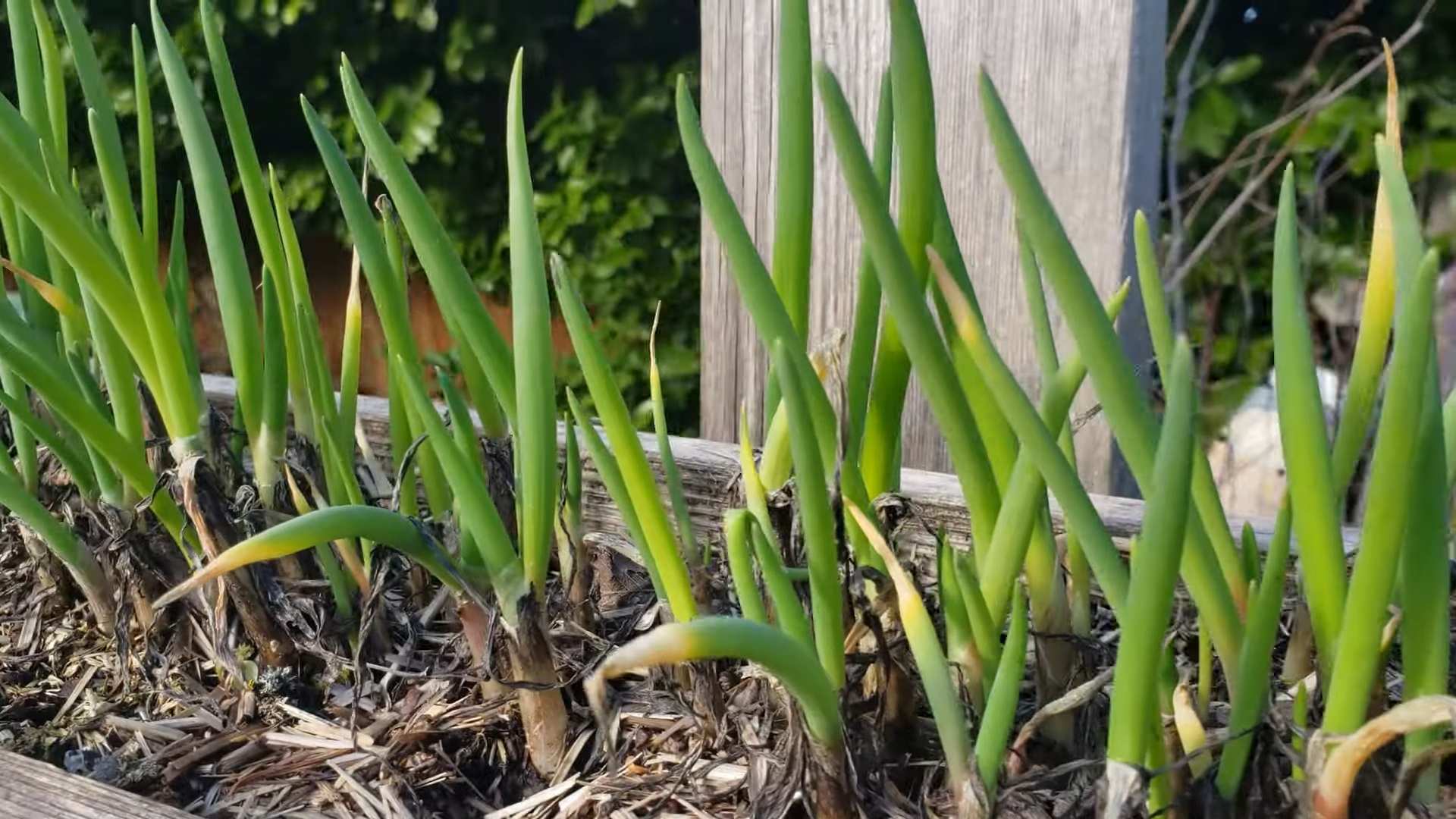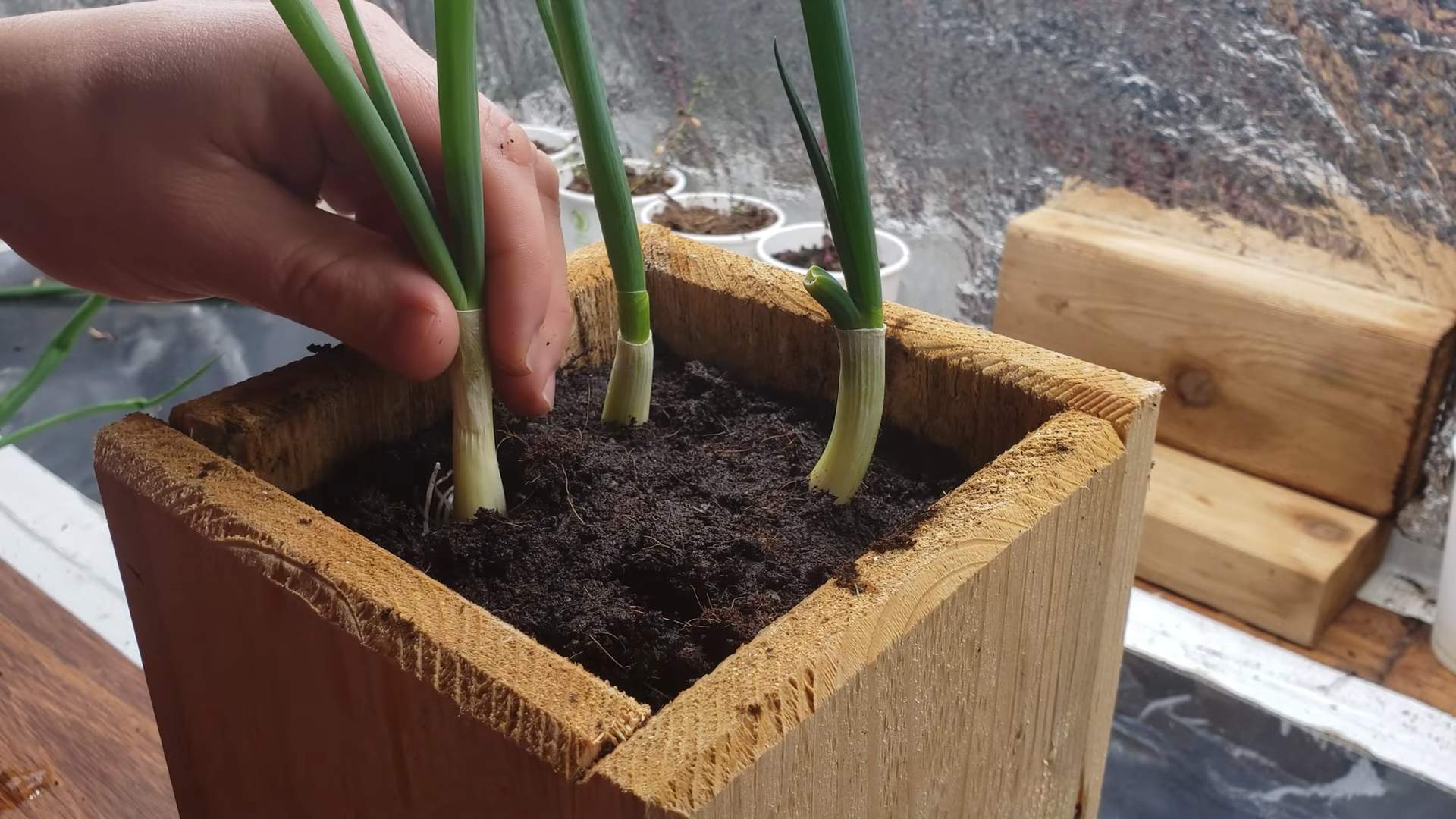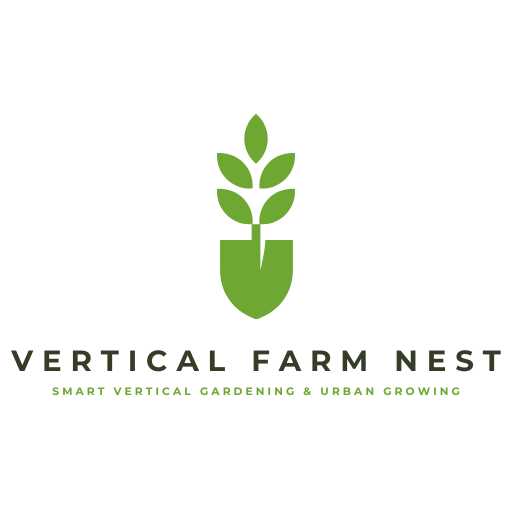Growing Green Onions Hack: Unlock the secrets to a never-ending supply of fresh, flavorful green onions right from your own kitchen! Imagine never having to buy green onions from the store again – always having them on hand to elevate your favorite dishes. Sounds amazing, right? This simple DIY project is not only incredibly rewarding but also surprisingly easy, even if you don’t have a green thumb.
The practice of regrowing vegetables isn’t new. For generations, resourceful gardeners have been extending their harvests and minimizing waste by propagating plants from scraps. Think of it as a modern take on age-old gardening wisdom! This growing green onions hack taps into that tradition, offering a sustainable and cost-effective way to enjoy fresh produce.
In today’s world, where sustainability and saving money are more important than ever, this DIY trick is a game-changer. We all know how quickly those bunches of green onions can wilt in the fridge, leading to food waste and unnecessary expenses. With this simple method, you can say goodbye to those woes and hello to a continuous supply of fresh, vibrant green onions. I’m excited to share this easy and effective technique with you, so let’s get started and transform your kitchen into a mini green onion farm!

Never Buy Green Onions Again: The Ultimate Regrowing Guide!
Okay, let’s be honest, who hasn’t bought a bunch of green onions, used a few, and then watched the rest slowly wilt away in the fridge? It’s a culinary tragedy! But fear not, my friends, because I’m about to share a super easy DIY hack that will let you regrow green onions from those very scraps, meaning you’ll practically never have to buy them again. Get ready to have a constant supply of fresh, flavorful green onions right at your fingertips!
What You’ll Need
Before we dive in, let’s gather our supplies. This is a pretty low-key project, so you probably already have most of this stuff:
* Green Onion Scraps: The stars of the show! You’ll need the white bulb end with the roots still attached. Don’t worry if the roots are a little short; they’ll grow.
* A Glass or Jar: Something to hold the onions and water. A small mason jar, a drinking glass, or even a recycled yogurt container will work perfectly.
* Water: Tap water is fine!
* Scissors or a Knife: For trimming (optional).
* Potting Soil (Optional): If you want to eventually transplant your green onions to a pot or garden.
* A Small Pot (Optional): For transplanting.
The Water Propagation Method: Step-by-Step
This is the easiest and most common method for regrowing green onions. It’s practically foolproof!
1. Prep Your Green Onion Scraps: Take your leftover green onions and cut off the green parts, leaving about 1-2 inches of the white bulb end with the roots attached. You can use the green parts you cut off in your cooking – no waste here! If the roots are excessively long, you can trim them slightly, but don’t cut them off completely.
2. Place in Water: Put the green onion scraps, root-end down, into your glass or jar. Add enough water so that the roots are submerged, but the water level doesn’t go too far up the green onion bulb. You want to avoid the bulb rotting.
3. Find a Sunny Spot: Place the jar in a bright, sunny location, like a windowsill. Green onions need sunlight to grow.
4. Change the Water Regularly: This is important! Change the water every 1-2 days to prevent bacteria growth and keep the water fresh. This will also help prevent any unpleasant odors.
5. Watch Them Grow!: Within a few days, you should start to see new green shoots emerging from the top of the bulb. It’s so satisfying to watch!
6. Harvest and Repeat: Once the green shoots have grown to a usable length (usually a few inches), you can harvest them by cutting them with scissors. Leave about an inch or two of the green part so they can continue to grow. And guess what? They’ll keep growing! Just keep changing the water and providing sunlight.
Transplanting to Soil (Optional): For a More Permanent Home
While you can keep your green onions growing in water indefinitely, transplanting them to soil can provide them with more nutrients and potentially lead to even more robust growth. Here’s how:
1. Wait for Root Development: Allow the roots to grow significantly in the water. You want a good network of roots before transplanting.
2. Prepare Your Pot: Choose a small pot with drainage holes. Fill it with good-quality potting soil.
3. Make a Hole: Use your finger or a small tool to create a hole in the soil large enough to accommodate the green onion bulb and roots.
4. Carefully Transplant: Gently remove the green onion from the water and carefully place it in the hole. Make sure the bulb is mostly buried, but the green shoots are exposed.
5. Water Thoroughly: Water the soil thoroughly after transplanting.
6. Find a Sunny Spot: Place the pot in a sunny location.
7. Water Regularly: Keep the soil consistently moist, but not soggy.
8. Fertilize (Optional): You can fertilize your green onions every few weeks with a diluted liquid fertilizer to encourage growth.
Tips and Tricks for Green Onion Success
* Don’t Overwater: Whether you’re growing in water or soil, avoid overwatering. Soggy conditions can lead to rot.
* Sunlight is Key: Green onions need plenty of sunlight to thrive. If you don’t have a sunny windowsill, you might consider using a grow light.
* Choose Healthy Scraps: Start with healthy-looking green onion scraps. Avoid using scraps that are already slimy or moldy.
* Experiment with Varieties: Try regrowing different varieties of green onions to see which ones you like best.
* Patience is a Virtue: While green onions grow relatively quickly, it still takes time. Be patient and don’t get discouraged if they don’t sprout immediately.
* Dealing with Yellowing: If the tips of your green onions start to turn yellow, it could be a sign of nutrient deficiency or overwatering. Try adjusting your watering schedule or adding a diluted fertilizer.
* Pest Control: Green onions are generally pest-resistant, but occasionally they can be affected by aphids or other small pests. If you notice any pests, try spraying them with a mixture of water and dish soap.
* Successive Planting: To ensure a continuous supply of green onions, start new scraps every week or two. This way, you’ll always have some ready to harvest.
* Harvesting for Continued Growth: When harvesting, always cut the green onions from the top, leaving at least an inch or two of green growth. This allows the plant to continue to produce new shoots.
* Consider Hydroponics: For a more advanced setup, you could explore hydroponic growing methods. This involves growing the green onions in a nutrient-rich solution without soil. There are many DIY hydroponic systems you can build at home.
* Observe and Adjust: Pay attention to how your green onions are growing and adjust your care accordingly. If they’re not growing well, try moving them to a different location, adjusting your watering schedule, or adding fertilizer.
* Don’t Throw Away the Roots: Even after you’ve harvested the green shoots multiple times, the roots will continue to grow. You can eventually transplant the entire plant to a larger pot or garden bed for even more growth.
* Use Filtered Water: If your tap water is heavily chlorinated, consider using filtered water for your green onions. Chlorine can sometimes inhibit growth.
* Rotate Your Crops: If you’re growing green onions in soil, rotate your crops regularly to prevent nutrient depletion. This means planting them in a different location each time.
* Companion Planting: Green onions are known to be good companion plants for many vegetables, such as tomatoes, peppers, and cabbage. Planting them together can help deter pests and improve growth.
* Enjoy the Freshness!: The best part of regrowing your own green onions is enjoying the fresh, flavorful taste in your cooking. Add them to salads, soups, stir-fries, or use them as a garnish.
Troubleshooting Common Issues
* Rotting Bulbs: If the base of your green onion bulb starts to rot, it’s usually a sign of overwatering. Make sure the water level isn’t too high and change the water frequently.
* Slow Growth: Slow growth can be caused by a lack of sunlight, nutrients, or water. Make sure your green onions are getting enough sunlight and water, and consider adding a diluted fertilizer.
* Yellowing Leaves: Yellowing leaves can be a sign of nutrient deficiency, overwatering, or underwatering. Adjust your watering schedule and consider adding a diluted fertilizer.
* Pests: If you notice any pests, try spraying them with a mixture of water and dish soap. You can also try using neem oil, a natural insecticide.
So there you have it! With a little bit of effort, you can easily regrow green onions from scraps and enjoy a constant supply of fresh, flavorful herbs. Happy growing!

Conclusion
So, there you have it! This simple yet incredibly effective growing green onions hack is a game-changer for anyone who loves fresh, flavorful green onions at their fingertips. Forget those wilted, sad-looking bunches from the grocery store that cost a small fortune. With minimal effort and resources, you can cultivate a thriving supply of these culinary staples right in your own kitchen.
Why is this a must-try? Because it’s economical, sustainable, and incredibly rewarding. Imagine the satisfaction of snipping fresh green onions to garnish your soups, salads, tacos, or stir-fries, knowing you grew them yourself from scraps that would otherwise have been tossed in the trash. It’s a small act of self-sufficiency that makes a big difference in both your wallet and your environmental footprint.
Beyond the basic method, there are plenty of ways to personalize your green onion growing experience. Experiment with different containers – from repurposed yogurt containers to stylish mason jars. Try using different types of water – filtered, tap, or even rainwater. You can also explore different lighting conditions to see how they affect growth. Some people find that placing their green onions near a sunny window yields the best results, while others prefer using a grow light for more consistent growth, especially during the darker months.
Consider adding a diluted liquid fertilizer every few weeks to give your green onions an extra boost. A balanced fertilizer, diluted to half strength, can provide the essential nutrients they need to thrive and produce even more flavorful greens. Just be careful not to over-fertilize, as this can lead to leggy growth and a less intense flavor.
Another variation is to eventually transplant your regrown green onions into soil. Once they’ve established a good root system in water, gently transfer them to a pot filled with well-draining potting mix. This will allow them to grow even larger and produce more substantial bulbs. You can even plant them directly in your garden if you live in a suitable climate.
Don’t be afraid to get creative and adapt this growing green onions hack to suit your own preferences and resources. The beauty of this method is its simplicity and adaptability.
We wholeheartedly encourage you to give this DIY trick a try. It’s a fun, easy, and rewarding project that will transform the way you think about food waste and home gardening. Plus, it’s a fantastic way to introduce children to the wonders of plant growth and the importance of sustainability.
Once you’ve experienced the joy of growing your own green onions, we’d love to hear about your experience! Share your photos, tips, and variations in the comments below. Let’s create a community of green onion enthusiasts and inspire others to embrace this simple yet powerful DIY trick. What containers did you use? Did you notice any difference in growth based on the type of water or lighting? What are your favorite ways to use your homegrown green onions? We can’t wait to hear from you!
Frequently Asked Questions
How long does it take for green onions to regrow?
Generally, you’ll start to see noticeable regrowth within a few days. Within a week or two, you should have enough green onions to harvest. The speed of regrowth depends on factors like temperature, light, and the initial health of the green onion scraps. Warmer temperatures and ample sunlight will encourage faster growth.
What part of the green onion do I need to regrow them?
You need the white part of the green onion, including the roots. Cut off the green tops, leaving about 1-2 inches of the white base with the roots attached. This is the part that will sprout new green shoots. Make sure the roots are still intact, as they are essential for absorbing water and nutrients.
Can I regrow green onions indefinitely?
While you can regrow green onions multiple times from the same base, the quality and vigor of the regrowth may diminish over time. After several cycles, the green onions may become thinner and less flavorful. To maintain a consistent supply of high-quality green onions, it’s best to start with fresh scraps every few weeks. You can also transplant the regrown onions into soil to encourage more robust growth.
What kind of container should I use?
Almost any container that can hold water will work. Small glasses, jars, bowls, or even plastic cups are all suitable options. The container should be deep enough to submerge the roots of the green onions in water. Make sure the container is clean to prevent bacterial growth. You can also use a dedicated propagation station or a hydroponic system for a more sophisticated setup.
How often should I change the water?
It’s important to change the water every 1-2 days to prevent bacterial growth and ensure the green onions have access to fresh, oxygenated water. Stagnant water can lead to rot and hinder growth. When changing the water, gently rinse the roots to remove any debris.
Do green onions need sunlight to regrow?
Yes, green onions need sunlight to regrow. Place your container near a sunny window where they can receive at least 6 hours of sunlight per day. If you don’t have access to a sunny window, you can use a grow light to provide supplemental lighting. Adequate sunlight is essential for photosynthesis, which is the process by which plants convert light energy into chemical energy for growth.
Can I use tap water to regrow green onions?
Yes, you can use tap water to regrow green onions. However, if your tap water is heavily chlorinated, it’s best to let it sit out for 24 hours before using it to allow the chlorine to dissipate. Alternatively, you can use filtered water or rainwater.
Can I plant the regrown green onions in soil?
Yes, you can plant the regrown green onions in soil. Once they’ve developed a good root system in water, gently transplant them to a pot filled with well-draining potting mix. You can also plant them directly in your garden if you live in a suitable climate. When transplanting, be careful not to damage the roots. Water thoroughly after planting.
What kind of soil should I use for planting green onions?
Use a well-draining potting mix that is rich in organic matter. A mixture of compost, peat moss, and perlite is ideal. Avoid using heavy clay soil, as it can become waterlogged and lead to root rot.
How often should I water green onions planted in soil?
Water the green onions regularly, keeping the soil consistently moist but not waterlogged. Check the soil moisture by sticking your finger into the soil. If the top inch of soil feels dry, it’s time to water.
Can I fertilize regrowing green onions?
Yes, you can fertilize regrowing green onions to encourage faster growth and more flavorful greens. Use a diluted liquid fertilizer every few weeks. A balanced fertilizer, diluted to half strength, is a good option. Be careful not to over-fertilize, as this can lead to leggy growth and a less intense flavor.
What are some common problems when regrowing green onions?
Some common problems include rot, slow growth, and yellowing leaves. Rot is usually caused by stagnant water or bacterial growth. Slow growth can be due to insufficient sunlight or nutrients. Yellowing leaves can be a sign of overwatering or nutrient deficiency. To prevent these problems, change the water regularly, provide ample sunlight, and fertilize as needed.
How do I harvest the regrown green onions?
Simply snip off the green tops with scissors as needed. Leave about an inch of the green tops attached to the white base to allow for continued regrowth.
Are there any other vegetables I can regrow like this?
Yes, there are several other vegetables you can regrow from scraps, including celery, lettuce, bok choy, and leeks. The process is similar to regrowing green onions: place the base of the vegetable in water and wait for it to sprout new growth.





Leave a Comment